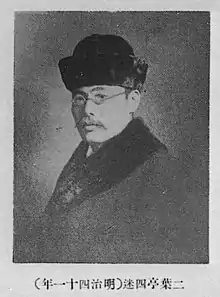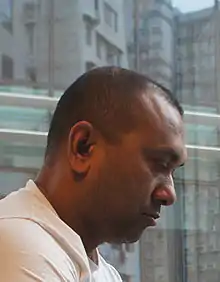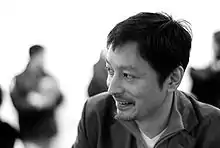東京外国語大学 | |
.jpg.webp) | |
| Type | National |
|---|---|
| Established | 1873 / 1949 |
| Endowment | N/A |
| President | Kayoko Hayashi |
Academic staff | 230[1] |
Administrative staff | 337 |
| Undergraduates | 3,769 |
| Postgraduates | 573 |
| Location | , Tokyo , Japan |
| Campus | Suburban |
| Colors | Peony pink |
| Nickname | N/A |
| Affiliations | FUU, EUIJ, CESFNUTA |
| Mascot | N/A |
| Website | www |
 | |
Tokyo University of Foreign Studies (東京外国語大学, Tōkyō Gaikokugo Daigaku), often referred to as TUFS, is a specialist national research university in Fuchū, Tokyo, Japan.
TUFS is primarily devoted to foreign language, international affairs and foreign studies. It also features an Asia-African institution.[2]
History
The University is the oldest academic institution devoted to international studies in Japan. It began as Institute for Research of Foreign Documents (蛮書調所, Bansho Shirabesho), a Tokugawa shogunate's translation bureau set up in 1857.
It was subsequently established as an independent educational and research institution with the name Tokyo School of Foreign Languages (東京外国語学校, Tōkyō gaikokugo gakkō) in 1899.
In 1999, the University celebrated both the 126th anniversary of its original establishment and the 100th anniversary of its independence. The campus was moved to its present location, where students can study in a modern, hi-tech environment.
Departments
There are 26 departments of language, i.e. the languages students can major at TUFS. Some languages are rarely taught in Japan or elsewhere the world.[3]
- Japanese Studies
- East Asian Studies
- Southeast Asian Studies
- Indonesian
- Malaysian
- Tagalog (Filipino)
- Thai
- Laotian
- Vietnamese
- Cambodian (Khmer)
- Burmese
- South and West Asian Studies
- European and American Studies I
- English
- German
- European and American Studies II
- French
- Italian
- Spanish
- Portuguese
- Russian and East European Studies
Affiliated institutions and organizations
Affiliated institutions and organizations at the university include:
- The Research Institute for Languages and Cultures of Asia and Africa (ILCAA)
Campus and dormitories

The primary TUFS campus in Fuchu is situated in Asahi-cho near Tama Station of the Seibu Tamagawa Line. Classes are mainly held in the Research and Lecture building and, for international students, the Japanese Language Center.[4] The campus also features a library, gymnasium, sports field, cafeteria, and small shop, with another convenience store located adjacent to the North Arrival Court.
On-site accommodation is available to international students and local students, in the form of the three International Residence Halls located at the ‘rear’ of the campus by the sports field. Two of the buildings provide studio apartment-sized single rooms for incoming students, as well as a limited number of ‘family’-sized apartments. Arranged in a wedge-shaped configuration, two sides of the wedge are lined with rooms, with an uncovered atrium in the centre. Completed first, amenities such as a communal kitchen and music room are located in Building 1. Building 2, completed later and featured to the right, moves the showers (and hot water supply) out of the individual rooms and to a communal shower and laundry area located on each floor. The newest Building 3 is located next to Building 2 and offers single rooms to international and local students.
SWA Group, a prominent landscape architecture firm, designed a gathering space for the campus, repurposing a former military base to create a multifunctional space suitable for social gatherings as well as studying. The space honors the Japanese belief that trees represent souls and SWA carefully transplanted or incorporated all of the trees from the existing forest. Beyond being featured in Roger Yee's Educational Environments and Walter Roger's textbook Professional Practice of Landscape Architecture: A Complete Guide to Starting and Running Your Own Firm, the plaza won a National ASLA Design Merit Award in 2003.[5][6]
School Festival (Gaigosai)
The School Festival of TUFS, Gaigosai, which usually takes place in the end of November, is known for its originality. Freshmen provide food of the countries they major in and Sophomore plays drama in the language they major. The plays are called gogeki (language plays). They sometimes use drama texts written in the language, but they often translate works in another language by themselves. Gogeki was given some grant by Japanese government.
List of Exchange Universities
TUFS has partner universities in 35 countries.[7]
- Taiwan
- Indonesia
- Malaysia
- South Korea
- Laos
- Mongolia
- Philippines
- Thailand
- Vietnam
- Singapore
- India
- Cambodia
- China
- Hong Kong
- Australia
- Brazil
- Turkey
- Ankara University
- Boğaziçi University
- Çanakkale 18 Mart University
- Syria
- Egypt
- Canada
- United States
- Uzbekistan
- Czech Republic
- France
- Ireland
- Italy
- Portugal
- Spain
- United Kingdom
- Russia
- Germany
Evaluation from Business World
| Ranking | |
|---|---|
| all universities in Japan | 6th[8] out of all the 778[9] universities which existed as of 2010 |
| Source | 2010 Survey[8] by Weekly Economist 〈ja〉 on the ranking of universities according to the numerousness of the number of the officers & managers produced by each university in consideration of the number of graduates |
Notable alumni and faculty members



.jpg.webp)

Alumni
- Futabatei Shimei, novelist
- Nitobe Inazō, educator
- Firoz Mahmud, visual artist, Bangladesh
- Jinzai Kiyoshi, novelist
- Jun Ishikawa, author
- Masahiko Shimada, author
- Nankichi Niimi, author
- Chūya Nakahara, poet
- Kafū Nagai, author
- Mari Yonehara, essayist
- Oh Seon-hwa, Professor at Takushoku University
- Hamada Kazuyuki, politician, Member of the House of Councillors, Parliamentary Vice-Ministers for Foreign Affairs
- Hashimoto Ben, politician, Member of the House of Representatives of Japan
- Hashimoto Mantaro, linguist and sinologist
- Hiroshi Saitō, politician, former Governor of Yamagata Prefecture
- Uchiyama Iwataro, politician, former Governor of Kanagawa Prefecture
- Nakajima Mineo, First President of Akita International University, a former President of Tokyo University of Foreign Studies
- Sakai Kuniya, President of Kanda University of International Studies
- Sakae Osugi, Anarchist
- Yasuhiko Nagano, Deputy Director-General of Graduate University for Advanced Studies, Professor Emeritus of National Museum of Ethnology (Japan)
- Matsuzono Makio, Professor Emeritus, Fourth Director-General of National Museum of Ethnology (Japan)
- Hiroji Kataoka, Professor of Urdu at Daito Bunka University
- Shinji Maejima, Orientalist
- Okakura Kakuzō, scholar
- Maeda Yoshinori, Tenth President of NHK
- Morohoshi Sayaka, journalist
- Okakura Kakuzō, scholar
- Shinichiro Sawai, Film Director
- Yoshio Ōkubo, President of Nippon Television
- Yukihide Takekawa, singer-songwriter, Vocalist of Godiego
- Yūko Nakamura, actress
- Genki Hitomi, Singer, Vocalist of Vow Wow
- Aoki Satoshi, former Chairperson of Honda, a former Chairperson of Japan Automobile Manufacturers Association
- Yamashita Hideki, President of Shueisha
- Murakami Koichi, former President of Fuji Television
- Hasegawa Kouji, first CEO of Shuto Expressway
- Mizukami Kenya, former Chairperson of Yomiuri Shimbun
- Arakawa Shoshi, CEO of Bridgestone
- Fujiwara Sakuya, former Bank of Japan Vice President
- Saiga Fumiko, former Judge of the International Criminal Court, a former Japanese Ambassador to the United Nations
- Sato Satoru, Japanese Ambassador to Spain
- Yamamoto Keiji, Japanese Ambassador in charge of Inspection
- Komano Kinichi, Japanese Ambassador to Iran
- Nishioka Atsushi, Japanese Ambassador to Djibouti
- Sato Soichi, Japanese Ambassador to Dominican Republic
- Hoshi Hideaki, Japanese Ambassador to Estonia
- Myoui Ryozo, Japanese Ambassador to Angola
- Minagawa Kazuo, Japanese Ambassador to Uganda
- Fujita Tadashi, former Japanese Ambassador in charge of disarmament and nonproliferation
- Tanaka Saburo, former Japanese Ambassador to Cuba, Deputy director of Naicho
- Inoue Masayuki, former Japanese Ambassador to Bangladesh
- Hanada Marohito, former Japanese Ambassador to Mongolia
- Kidokoro Takuo, former Japanese Ambassador to Mongolia
- Nakasone Goro, former Japanese Ambassador to Paraguay
- Honda Hitoshi, former Japanese Ambassador to Finland
- Tokura Eiji, former Japanese Ambassador to Sweden
- Arai Koichi, Last Japanese Ambassador to East Germany
- Tanabe Ryuichi, former Japanese Ambassador to Poland
- Katsu Shigeo, Vice President of World Bank
- Kanbara Masanao, CEO of Mitsubishi Rayon
- Kuwahara Michio, CEO of Daiei
- Shimizu Shinjiro, former President of Mitsui & Co.
- Kodera Kei, former President of Toys "R" Us(Japan)
- Hidaka Nobuhiko, President of GartnerJapan
- Keizo Morikawa, President of Cosmo Oil
- Melt-Banana, musician
- Jalsan, tulku and Professor of Mongolian at Inner Mongolia University[10]
- Takuma Nakahira, Photographer and Photography Critic
- Yasuhiro Matsuda, professor of University of Tokyo (international politic), Yasuhiro Nakasone Award (2011)
Faculty
- Daryoush Ashouri, visiting professor
- Isolde Standish is an Australian and British Humanities Scholar and Film theorist specialised in East Asia.[11]
- Kitamura Hajime, linguist
- Masao Yamaguchi, anthropologist, professor emeritus
- Nakae Chomin, former president
- Tadahiko Shintani, linguist
- Takeshi Suzuki, professor of Urdu
- Ram Prakash Dwivedi, Visiting Professor[12][13][14]
Academic rankings
| WE National[15] | Employment | 16 | |
|---|---|---|---|
| NBP Greater Tokyo[16][17] | Reputation | 9 | |
| Shimano National[18] | Selectivity | SA | |
| ENSMP World[19] | Alumni | 92 | |
| * The data of NBP is in 2009 rankings because of availability. | |||
TUFS is a specialized institution only in foreign language, international affairs and foreign studies, thus it is not as well known as other big universities such as University of Tokyo and Kyoto University. However, its prestigious position in Japan can be seen in the several rankings below.
General rankings
The university has been ranked 34th, 23rd and 20th out of 181 major universities during 2008–2010 in the ranking called "Truly strong universities(本当に強い大学)" by Toyo Keizai.[20][21]
According to the survey conducted by Nikkei HR in 2013, the TUFS won the first place in "working skills" ranking among Japanese universities. It shows that students grow their "working skills" through their studies at the university and they will learn faster and be operational once they have started their career.[22][23]
Research performance
Weekly Diamond reported that TUFS has the 5th highest research standard in Japan in terms of research fundings per researcher in COE Program.[24] In the same article, it's also ranked 3rd in terms of the quality of education by GP funds per student.
Alumni rankings
According to the Weekly Economist's 2010 rankings, graduates from TUFS have the 16th best employment rate in 400 major companies.[25]
École des Mines de Paris ranks TUFS University as 92nd in the world in 2011 in terms of the number of alumni listed among CEOs in the 500 largest worldwide companies, although TUFS is a smaller university compared to other Japanese universities in the ranking.[26]
Popularity and selectivity
TUFS is one of the most selective universities in Japan. Its entrance difficulty is usually considered one of the top among 180 national and public universities.[27][28][29]
Notes
- ↑ "Facts and Figures – About TUFS – Tokyo University of Foreign Studies". Archived from the original on 22 October 2017. Retrieved 29 July 2016.
- ↑ "Education and Research Institutions – About TUFS – Tokyo University of Foreign Studies". Archived from the original on 22 December 2017. Retrieved 29 July 2016.
- ↑ "言語文化学部(仮称)・国際社会学部(仮称)入学者選抜要項|言語文化学部(仮称)・国際社会学部(仮称)入試|東京外国語大学". Archived from the original on 25 August 2011. Retrieved 30 July 2011.
- ↑ "Campus Map – About TUFS – Tokyo University of Foreign Studies". Archived from the original on 24 April 2016. Retrieved 29 July 2016.
- ↑ http://swacdn.s3.amazonaws.com/1/bffc076a_tokyouniversity.pdf
- ↑ "ASLA Announces its 2003 Professional Awards | asla.org". www.asla.org. Retrieved 4 December 2018.
- ↑ "Partner Institutions – International Affairs – Tokyo University of Foreign Studies". Retrieved 29 July 2016.
- 1 2 Is it a story of the past that graduates from famous universities can easily move up the career ladder? / RECRUIT AGENT(in Japanese)
- ↑ University reform reference materials / Cabinet Secretariat(in Japanese)
- ↑ "贾拉森—— 内大教授、博导、南寺活佛", Inner Mongolia University News, 13 February 2008, archived from the original on 18 July 2011, retrieved 4 June 2010
- ↑ "イゾルダ・スタンディッシュ". 教員インタビュー (in Japanese). Retrieved 15 April 2020.
- ↑ Dwivedi, Ram Prakash (2020). "Your Name: A Study of Imagery and Post-Postmodernity in Cinema". doi:10.13140/RG.2.2.30776.98565.
{{cite journal}}: Cite journal requires|journal=(help) - ↑ Dwivedi, Ram Prakash. Japan Journal: Jazire ke Jajman.
- ↑ Dwivedi, Ram Prakash (29 June 2017). "A Discourse on Modern Civilization: The Cinema of Hayao Miyazaki and Gandhi". International Journal of Humanities and Social Science Invention. 6: 63–68.
- ↑ "Employment rate in 400 major companies rankings" (in Japanese). Weekly Economist. 2011. Retrieved 29 April 2011.
- ↑ "Nikkei BP Brand rankings of Japanese universities" (in Japanese). Nikkei Business Publications. 2010. Retrieved 29 April 2011.
- ↑ "Nikkei BP Brand rankings of Japanese universities" (in Japanese). Nikkei Business Publications. 2009. Retrieved 29 April 2011.
- ↑ "GBUDU University Rankings" (in Japanese). YELL books. 2009. Retrieved 29 April 2011.
- ↑ "ENSMP World University Rankings" (PDF). École nationale supérieure des mines de Paris. 2011. Retrieved 29 April 2011.
- ↑ "本当に強い大学【2010年版】総合ランキング・トップ100――東大5連覇、京大が阪大を逆転、関学躍進(1) | | 投資・経済・ビジネスの東洋経済オンライン". Archived from the original on 13 March 2012. Retrieved 6 June 2012.
- ↑ TUFS only has the Humanities department, so it has a tendency to be ranked weaker. see Truly Strong Universities#Criticisms
- ↑ "本学の「就業力」についての記事が、日経新聞に掲載されました|トピックス一覧|東京外国語大学". Archived from the original on 23 September 2016. Retrieved 30 July 2016.
- ↑ "「就業力」ランキング 1位は東京外語大". 17 June 2013.
- ↑ "週刊ダイヤモンド" ダイヤモンド社 2010/2/27 http://web.sapmed.ac.jp/kikaku/infomation/0227daiyamondokiji.pdf
- ↑ "Employment rate in 400 major companies rankings". Weekly Economist (in Japanese). 2011. Retrieved 29 April 2011.
- ↑ "Archived copy" (PDF). Archived from the original (PDF) on 20 July 2011. Retrieved 26 April 2011.
{{cite web}}: CS1 maint: archived copy as title (link) - ↑ Private universities apply different kind of exams. Thus it's only comparable between universities in a same category.
- ↑ E.g. Yoyogi seminar published Hensachi (the indication showing the entrance difficulties by prep schools) rankings "Archived copy". Archived from the original on 22 April 2011. Retrieved 29 July 2016.
{{cite web}}: CS1 maint: archived copy as title (link) - ↑ Japanese journalist Kiyoshi Shimano ranks its entrance difficulty as SA (most selective/out of 11 scales) in Japan. 危ない大学・消える大学 2012年版 (in Japanese). YELL books. 2011. ASIN 4753930181.